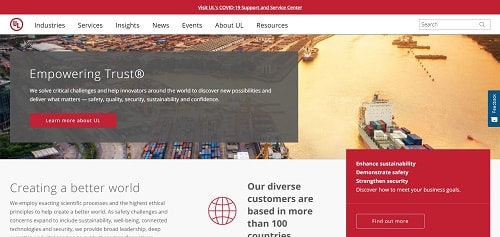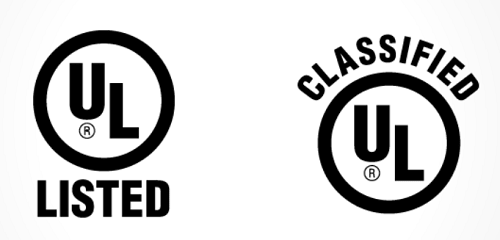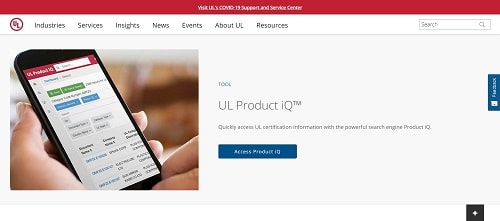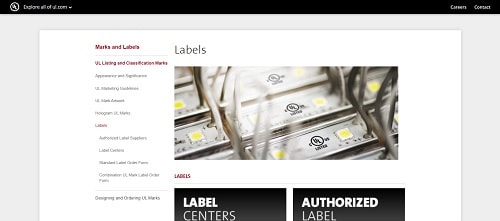Equipment safety is a broad and diverse topic, with individual requirements that pertain to specific product types, regions, and applications. In order to demonstrate compliance, many commercial equipment manufacturers will mark their products with certification logos that indicate that their products have been certified by a governing or standards-issuing entity as safe and ready for their intended use. These markings are important for inspectors, end-users, and the general public as a standardized way to display this information.
In the United States, a number of different organizations exist to protect workers and end consumers by ensuring that manufacturers and operators uphold the standards. Some examples are safety code developers such as the National Fire Protection Association (NFPA) and federal agencies including the Occupational Safety and Health Administration (OSHA) and the U.S. Food and Drug Administration (FDA). Another organization that plays a significant role in equipment manufacturing is the Underwriters Laboratory (UL), which develops safety, quality, and sustainability standards.
For end-users and operators, such as workers who use equipment in the food service industry, understanding what these markings stand for is an essential component of workplace safety. These businesses should not only purchase compliant equipment but must also maintain compliant operations. In fact, data from a UL field evaluation study showed that 63% of the equipment pieces inspected had deficiencies, some of them posing serious hazards.
We’ve created this guide to help you navigate the meaning and proper use of UL markings. We’ll explore how UL testing may differ from the other major safety agencies, what the UL standards cover, and how the different labels and marks should be interpreted and reviewed. UL labels and marks have been created as an easy way to quickly identify compliant equipment and provide a reference for their upkeep and ongoing maintenance needs. Since a safety program should not be a static process, taking time to fully understand UL markings can help ensure that your products are properly labeled and that you can maintain compliance throughout the life of your equipment.
We’ll discuss:

Equipment may carry a number of different markings to designate compliance with certain standards. There can also be variations among country, region, product type, and certifying organization, which can add some complexity. Generally speaking, the markings on a product can indicate which regions the product can be sold in or the energy and safety benchmarks it was tested against. In addition to UL, here are a few of the other most common commercial equipment certification markings.

The Underwriters Laboratory has been providing certifications for equipment since 1988 and has increased its scope and influence significantly over the past 30 years. Today, over 22 billion products are marked with UL labels each year. They maintain a catalog of over 100 different standards and provide testing, inspection, and certification services to manufacturers and businesses throughout the U.S.
The UL plays a major role in industries of all kinds and is especially active in the food and beverage industry. These are a few of the many solutions they provide to businesses operating in food services:
UL is a Nationally Recognized Testing Laboratory (NRTL) which means that it is capable of upholding the highest standards expected by OSHA. Other organizations we have discussed, such as ETL, are also considered to be an NRTL, and their markings are often used interchangeably with UL by manufacturers. A company may choose one particular NRTL marking for their equipment due to the testing schedule available, certification costs, or because one certification mark is more widely recognized by consumers in a particular market.
UL maintains support for over 100 different standards that can be used to certify products or operations. Customers can also purchase standards from UL and access their extensive catalog for reference. These are a few of the most popular UL standards, which will give you a good idea of the wide range of products that may be certified and bear a UL logo.
As is the case with UL 9560, some standards are also in direct alignment with U.S. standards maintained by the American National Standards Institute (ANSI). Given the frequent overlap, there is a process of continuous review and updating to ensure that all of the standards include the most recent requirements.

The exact labels and markings will differ according to the particular region that products are manufactured. You can find details for the Asia Pacific, Europe, and Latin America regions on their website. In the list below, we’ll explain the major UL marks used for products manufactured in North America.
UL categorizes products as Type L or Type R, and there’s a handy Product iQ database on their website for confirming which one is applicable. Type L products use a UL Mark with an issue, lot, or serial number, while Type R products contain a marking with a control number or fixed 4-character number associated with a UL file number.
In addition to these common markings, there are many additional options available for North America. A few examples are environmental and public health, water quality, and marine certifications. As you can see, the individual mark that is placed on each product will likely be unique based on various factors.

In order to design, print, and fabricate labels which include a UL Mark, a manufacturer must be part of the UL authorized supplier program. This program ensures that there is an adequate amount of oversight to the labeling process. In addition, it gives manufacturers and end-users confidence that the labels are accurate and true representations of compliance with the relevant standards.
In order to become a UL approved supplier, a company must demonstrate adherence to standards related to the major steps in label manufacturing. The detailed categories for these label and mark requirements are contained within UL 969, and we’ve summarized them below:
UL labels and marks are vital for equipment in a range of industries to signify that a piece of equipment complies with essential safety standards. While there are other certification options for many industries, UL certification is one of the most widely used. Importantly, products that carry UL marks are subject to UL’s ongoing Follow-Up Services, which confirm that the manufacturing process continues to meet applicable safety standards and requirements for those products.
When choosing certification labels, work with an authorized UL label supplier like MPC for durable metal labels. Metalphoto® photosensitive anodized aluminum labels, for instance, are a UL-approved material that offers the durability needed to withstand typical equipment operating conditions across many industries. Metalphoto provides superior resistance to chemicals, abrasion, solvents, extreme temperatures, and UV, with an expected exterior lifespan of more than 20 years. Metalphoto labels can be customized to the precise size, shape, thickness, and information you need, with a silver-colored face stock that’s high-contrast and easy to read, making them an ideal choice for UL labels. Thanks to their exceptional durability and suitability for harsh environmental conditions, Metalphoto® photosensitive anodized aluminum labels remain readable throughout the lifespan of your equipment.
To learn more about UL labels and marks, visit the following resources:
Our sales engineers are experts in automatic asset tracking, tagging and identification,a nd can answer all your questions. Get in touch now.
Lets Talk ›